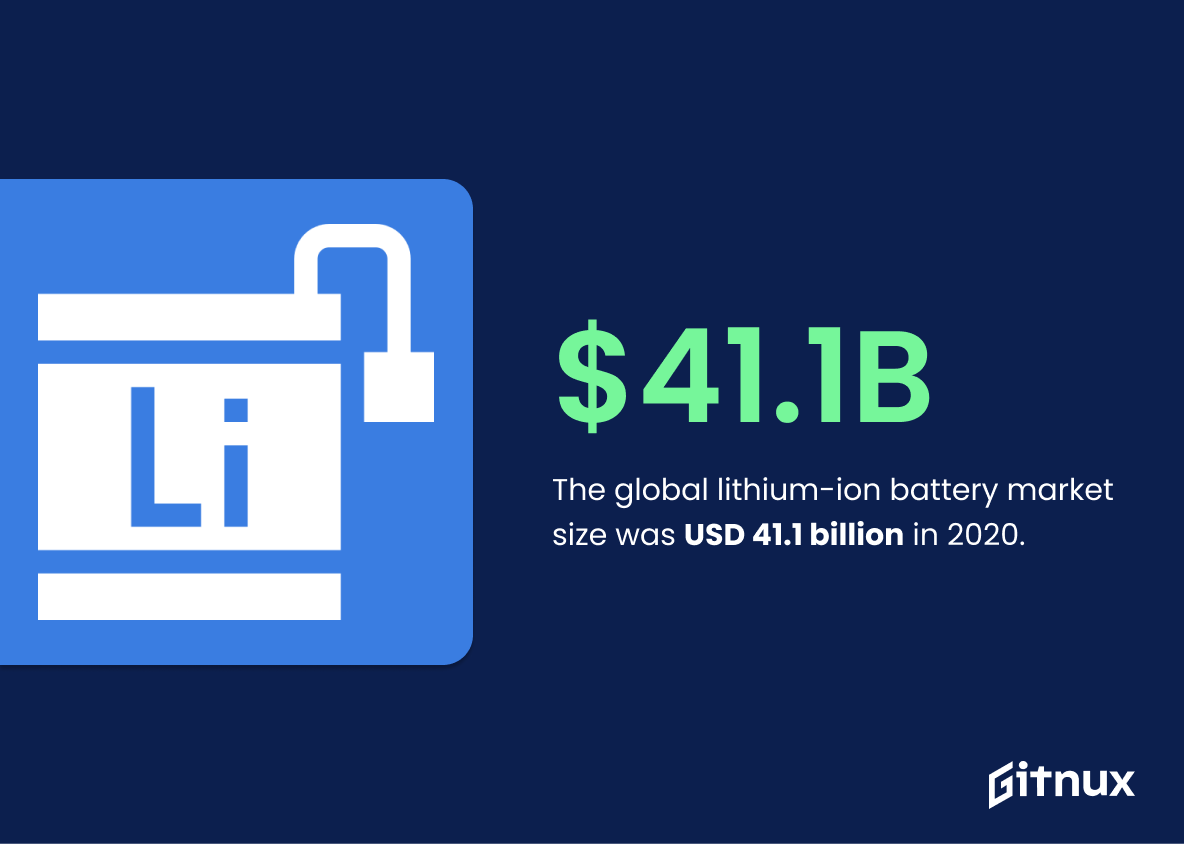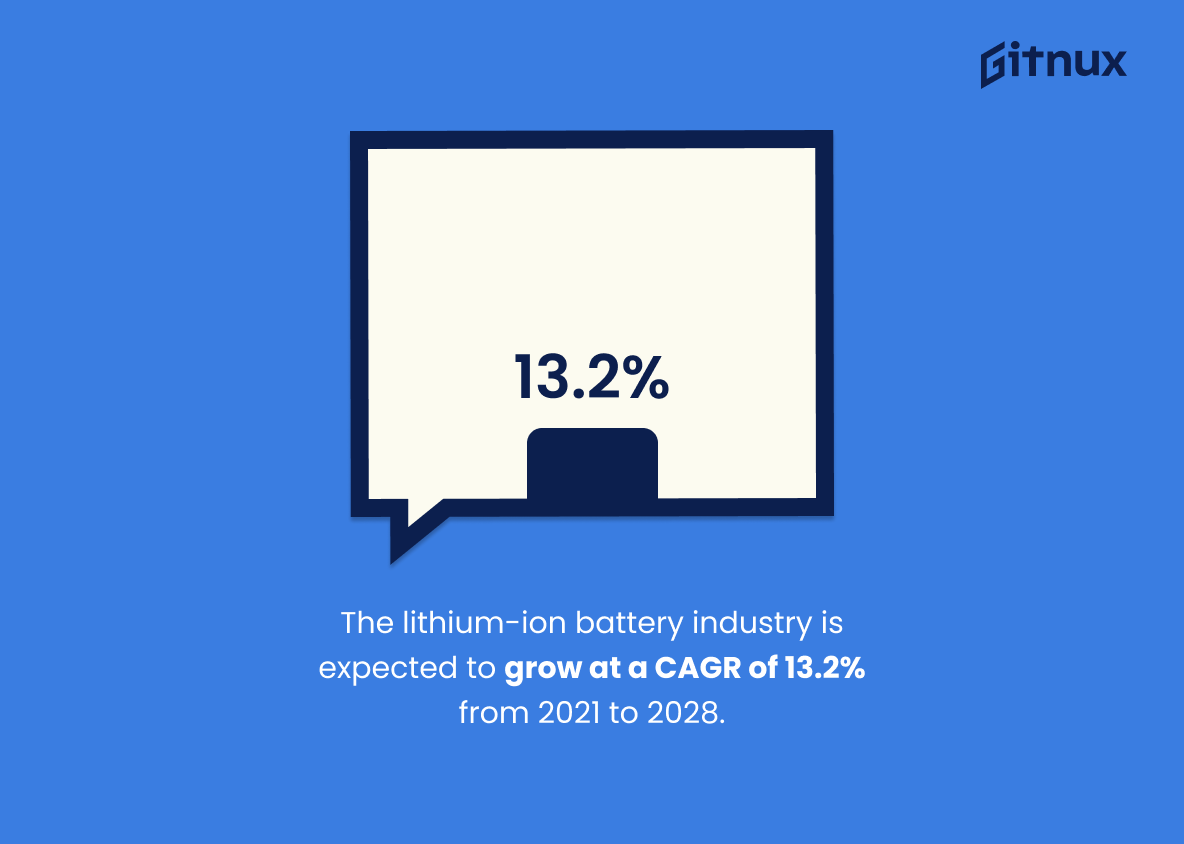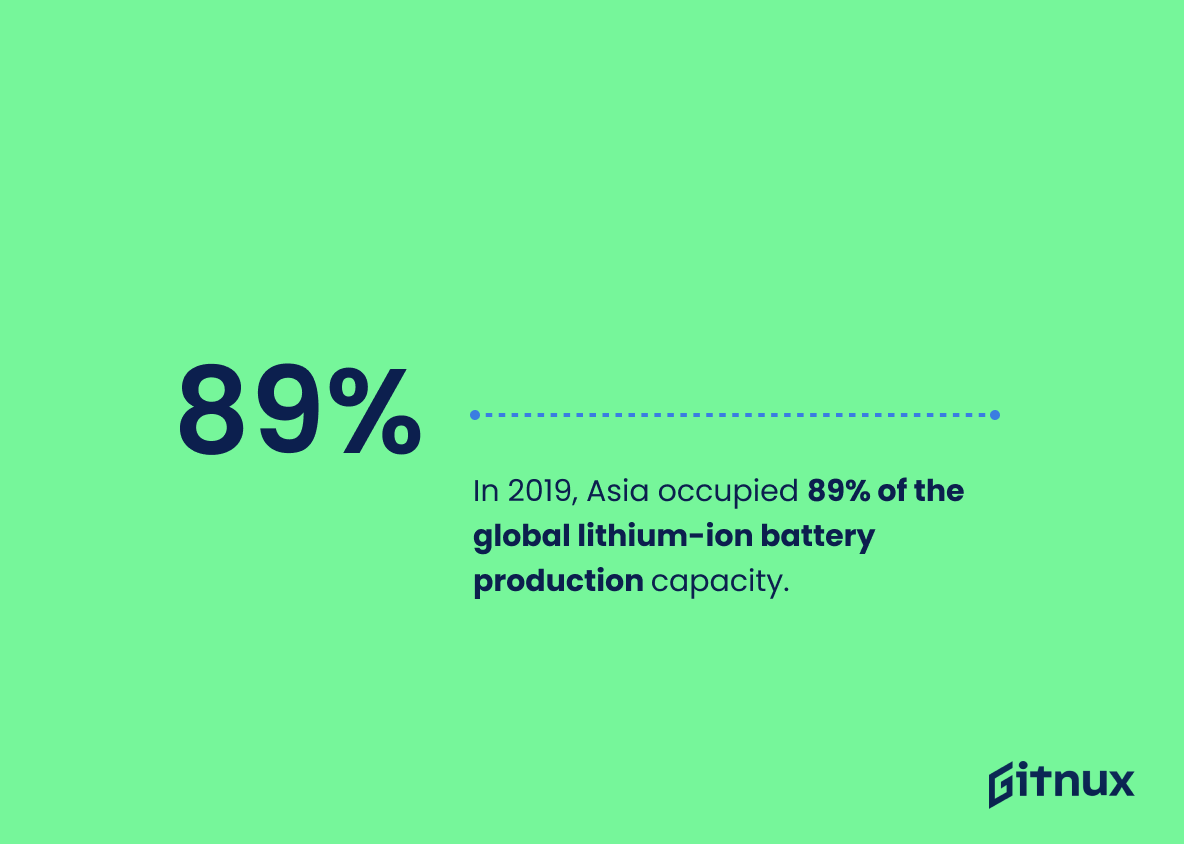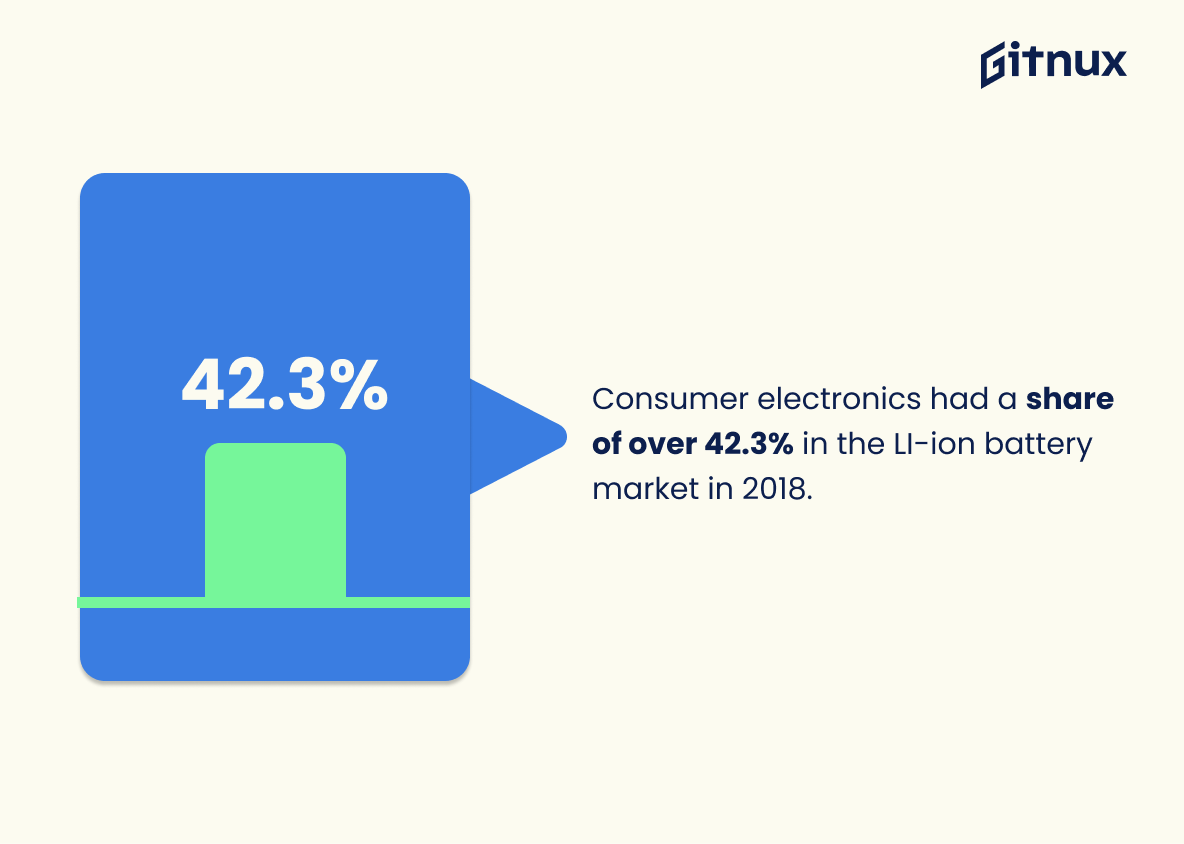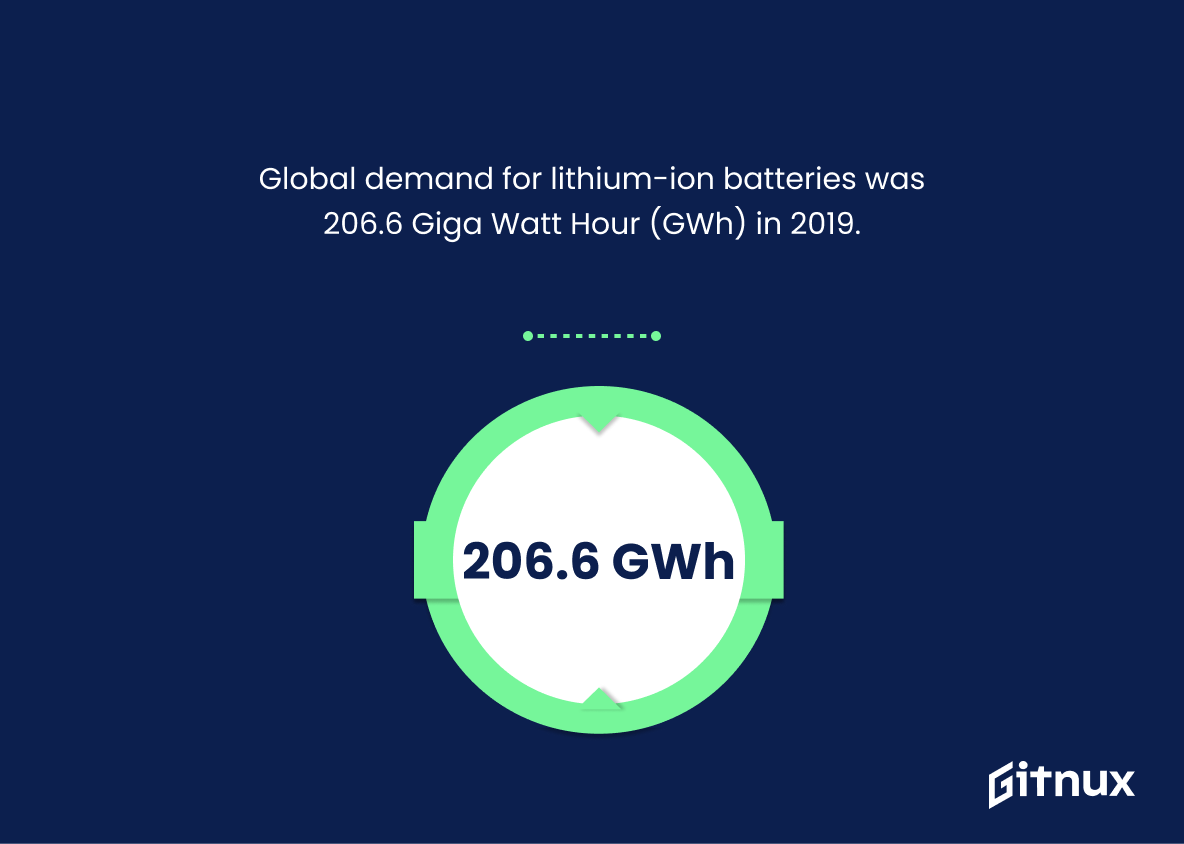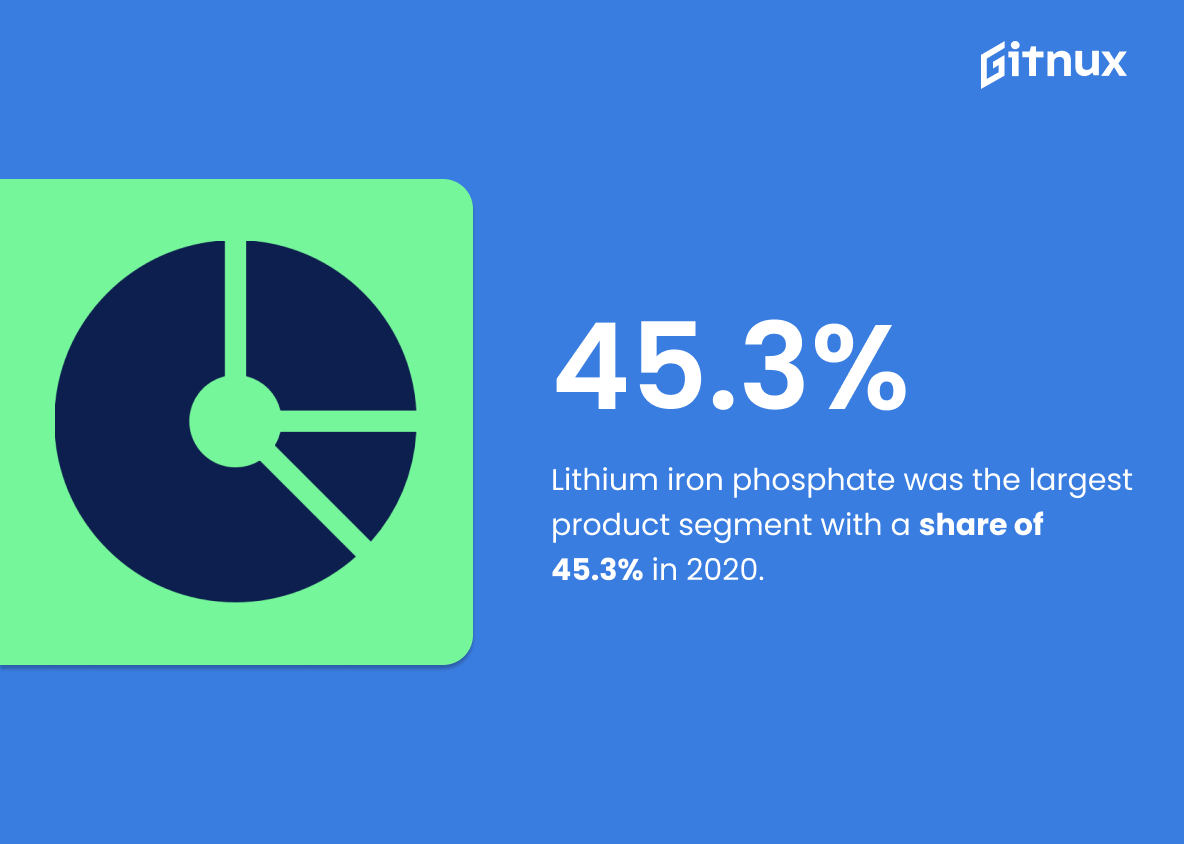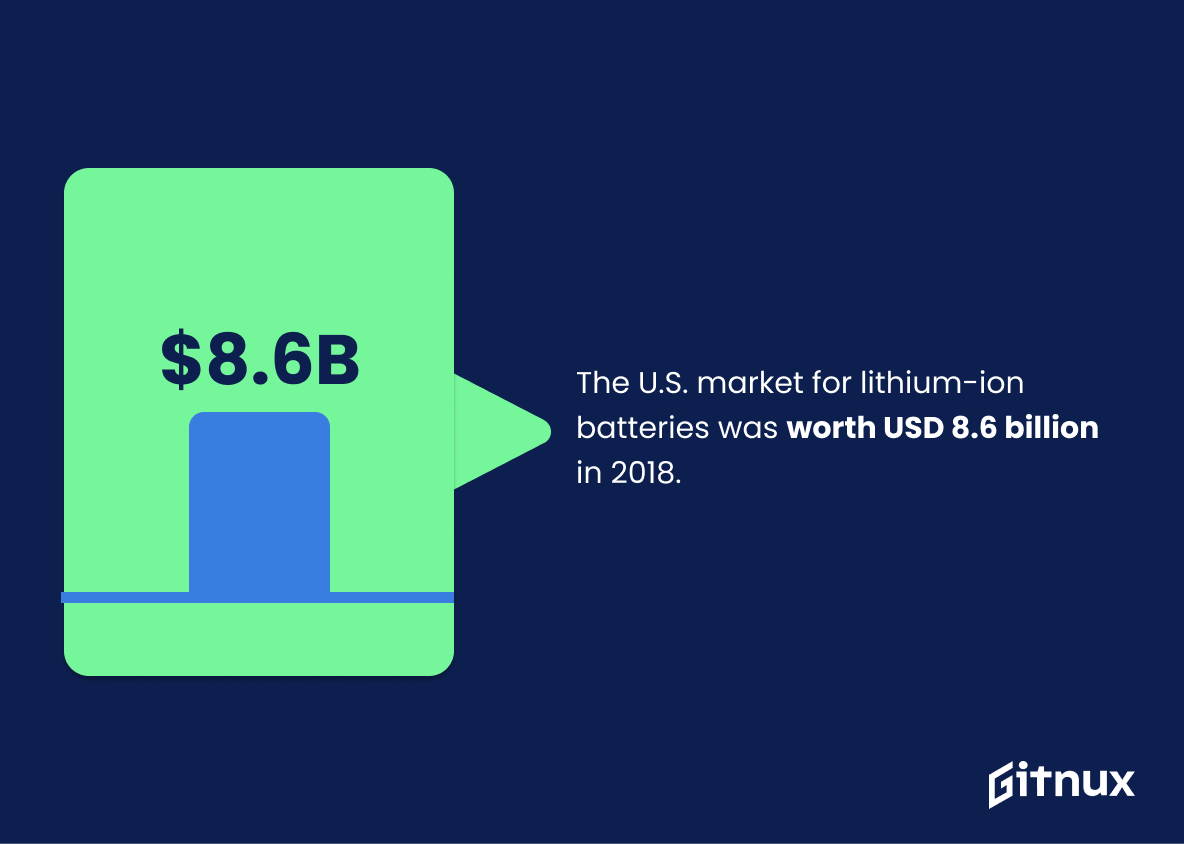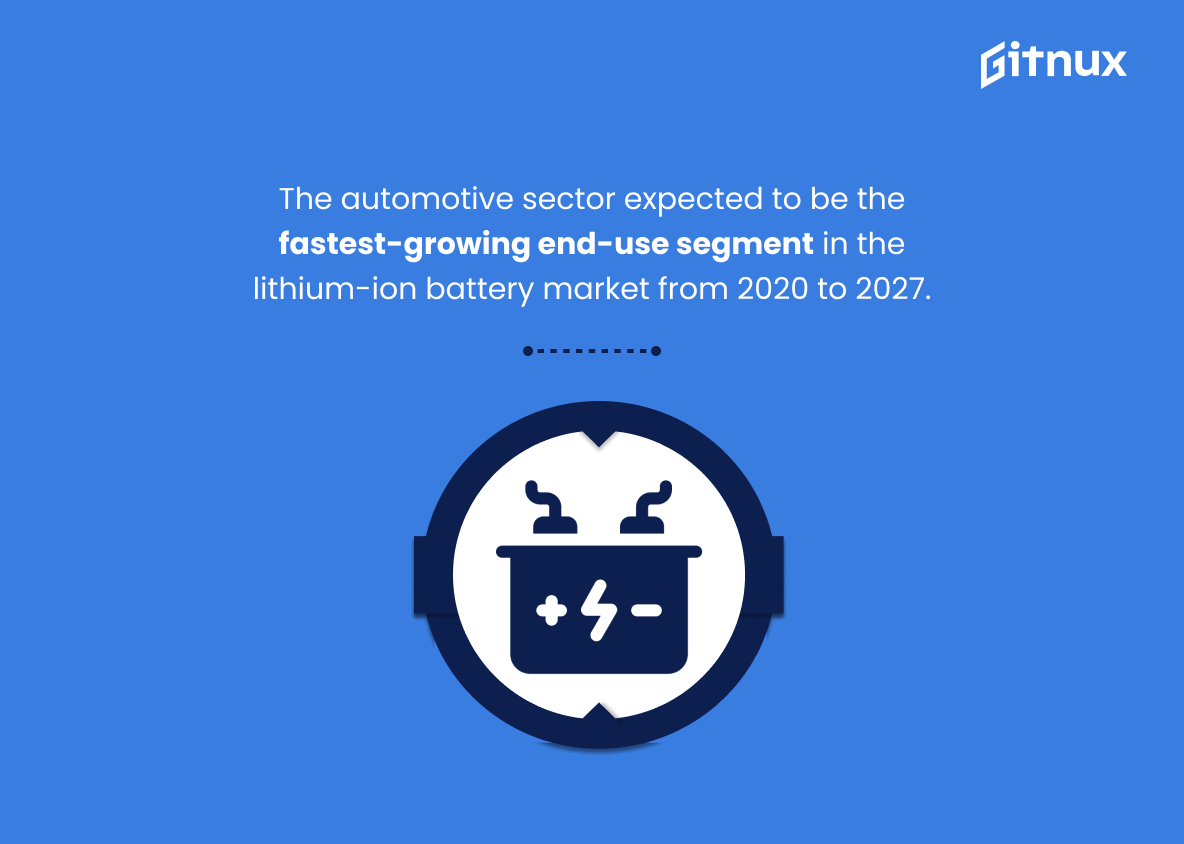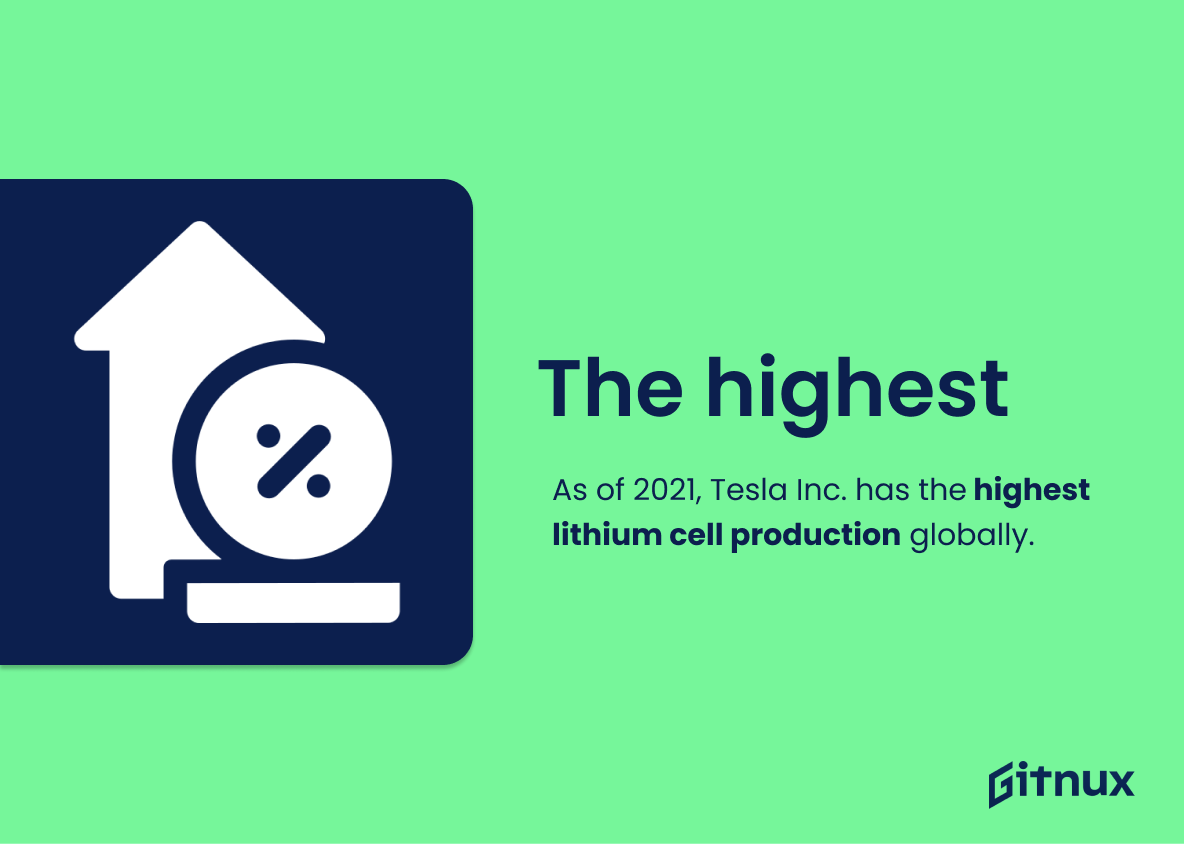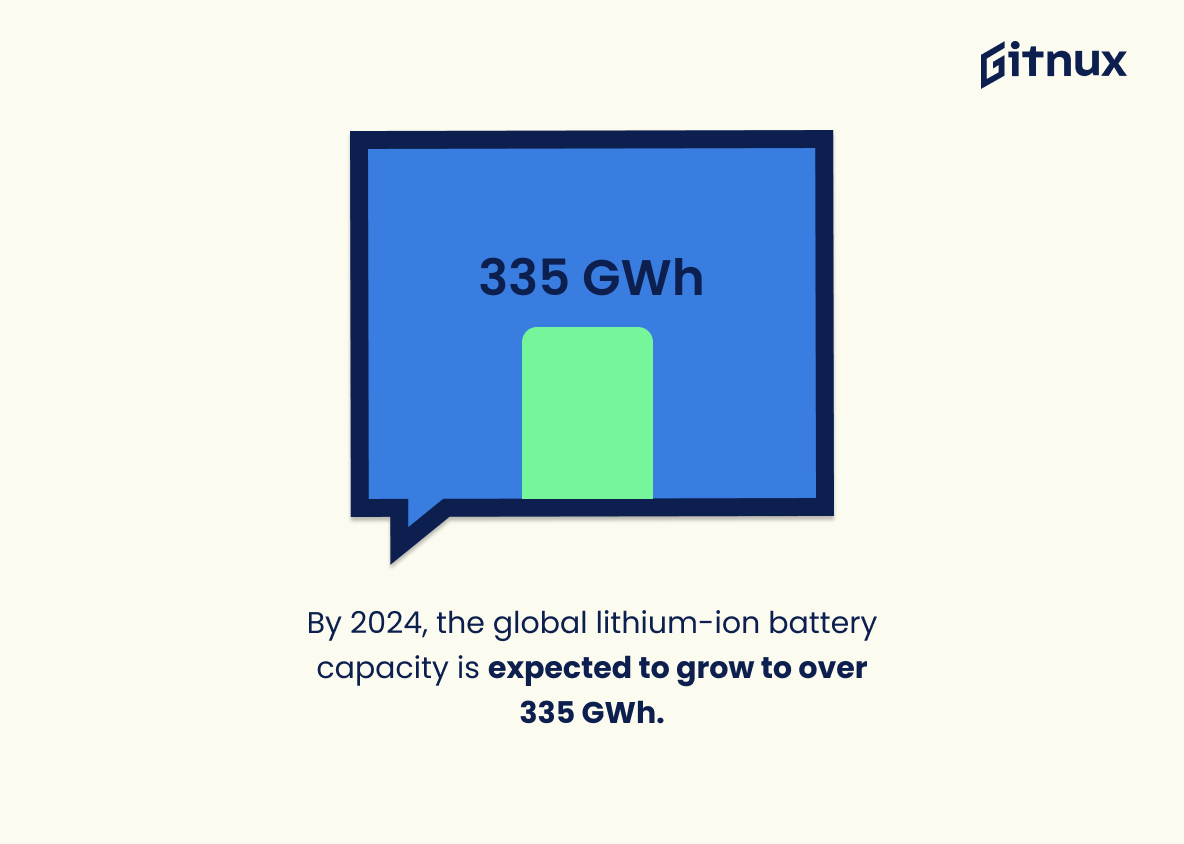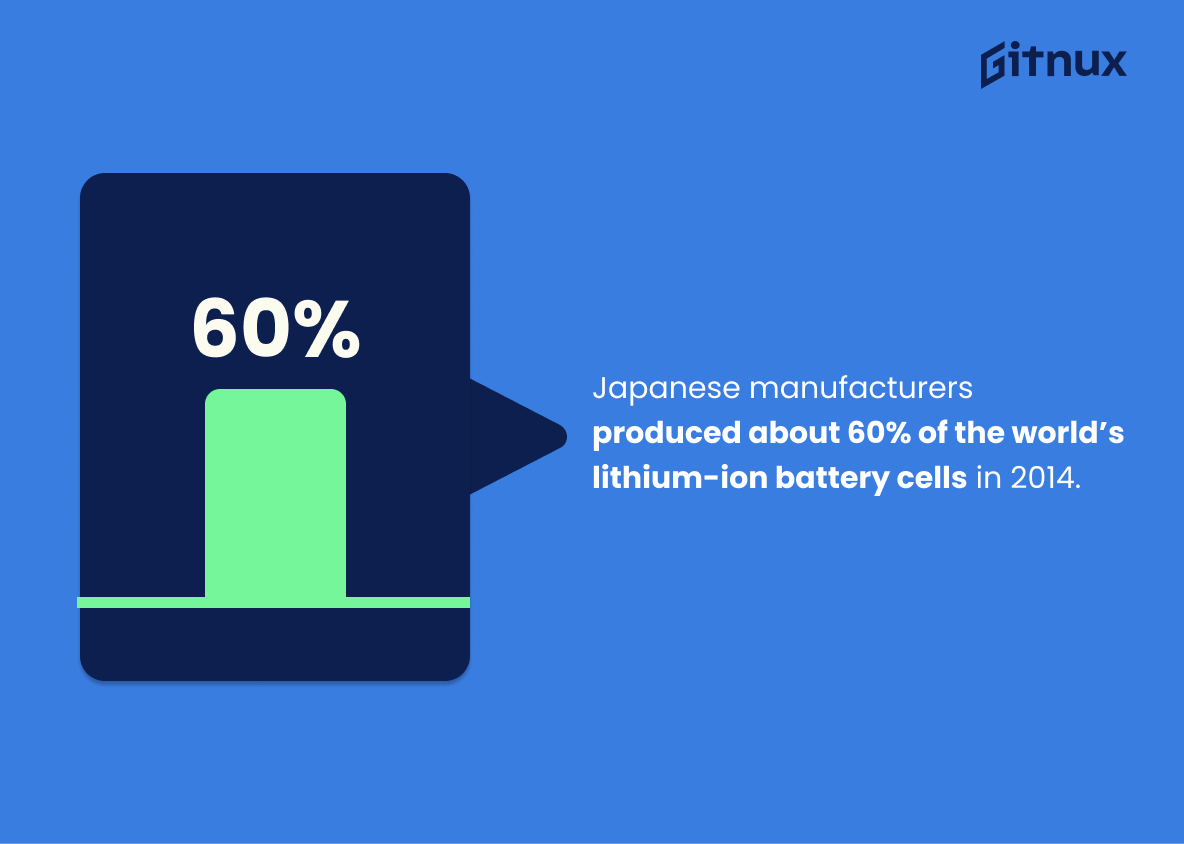In today’s high-tech world, power is not merely a necessity, it’s an imperative. Leading the charge, quite literally, is the lithium-ion battery industry, a powerful cornerstone of modern technology. From being the life-source of our smartphones and electric vehicles to enabling renewable energy storage solutions, lithium-ion batteries are sparking change around the globe.
This blog post delves into the fascinating industry statistics, presenting an insightful analysis of its growth trajectory, market dynamics, key players, and future predictions. Stay with us as we navigate the charged currents of the lithium-ion battery industry, illustrating its emphatic influence on our lives and the global economy.
The Latest Lithium Ion Battery Industry Statistics Unveiled
The global lithium-ion battery market size was USD 41.1 billion in 2020.
In the vast landscape of the lithium-ion battery industry, the $41.1 billion market size in 2020 provides a robust snapshot of the economic relevance of this sector. It stands as a testament to the industry’s daunting magnitude and potential for growth.
Not only does this value underline the significant financial implications of lithium-ion technology, but it also illuminates the substantial influence it has on numerous industries, from electronics to electric vehicles. Simply put, the pulsating heartbeat of the global lithium-ion battery market reverberates across economies, shaping trends and steering investment patterns in the energy storage domain.
The lithium-ion battery industry is expected to grow at a CAGR of 13.2% from 2021 to 2028.
The crux of the robust growth forecasted for the lithium-ion battery industry distills down to a scintillating CAGR of 13.2% from 2021 to 2028. This number culminates into more than just a figure; it stands as a testament to the industry’s imminent evolution, portraying the magnitude of its potential and the trajectory of its progress.
A blog post delving into the statistics of the Lithium-Ion Battery industry would be incomplete without this, as it offers readers a far-sighted view of the field. It signifies the lucrative opportunities, challenges, and dynamism that lay ahead in the industry, lending broad context to the topic, and grounding future predictions, lending depth to a blog post focused on industry statistics.
In 2019, Asia occupied 89% of the global lithium-ion battery production capacity.
By focusing on the impressive figure of 89%, we are immediately drawn to Asia’s major dominance in the sphere of lithium-ion battery production capacity in 2019. This data point, beyond just numbers, underscores the emerging narrative of Asia as the global powerhouse in this industry. This alone paints a vivid picture of the lithium-ion batteryscape, highlighting Asia’s significant role and its pivotal influence on the entire value chain of this industry.
Furthermore, it’s an undeniable indication of the shift in technological and manufacturing capabilities from the West to the East, shaping the future trajectory of the lithium-ion battery market. Such a hefty majority in production could also potentially have implications on pricing, availability, and even next-gen battery technology developments.
Consumer electronics had a share of over 42.3% in the LI-ion battery market in 2018.
Diving deep into the electromagnetic ocean of the LI-ion battery market, the significant 42.3% share held by consumer electronics in 2018 unveils a crucial narrative. Ascending this statistical mountain provides a panoramic view of the vibrancy and dynamics of the industry, emphasizing the profound symbiosis between our everyday devices and Lithium-Ion batteries. The prevalence of consumer electronics within this sphere reflects not only the burgeoning demand for portable power solutions but also the steady progression and development in the industry itself.
Indeed, this figure sparks an intriguing conversation about the future directions of both the LI-ion battery market and the electronics industry as it highlights their incessant dance of innovation and interdependence. As the world becomes more digitized, this statistic underpins the profound impact consumer electronics have on shaping trends and driving demand in the LI-ion battery landscape.
Global demand for lithium-ion batteries was 206.6 Giga Watt Hour (GWh) in 2019.
Podcasting substantial light on the lithium-ion battery industry’s magnitude and importance, the statement that the global demand for these power units reached a staggering 206.6 Giga Watt Hour (GWh) in 2019 vouches for the true scale of this industry. This colossal figure serves as a solid benchmark, underlining the immense reliance the world has developed on lithium-ion batteries and their widespread applications.
Such massive usage attests to their technological superiority over other energy storage devices. This industry, standing tall at 206.6 GWh in annual demand, is in the driver’s seat for powering everything from portable electronics and electric vehicles to grid storage systems. Consequently, its future prospects offer a promising vista – a glimpse of which is the impressive 2019 demand statistics.
Lithium iron phosphate was the largest product segment with a share of 45.3% in 2020.
Highlighting that lithium iron phosphate dominated the product sector with a 45.3% share in 2020 underscores its significant influence within the Lithium Ion Battery Industry. Its commanding presence conveys its widespread acceptance and usage, validating its effectiveness and reliability as a dependable power solution. The insight allows us to understand the current trends in energy storage technologies, providing industry players and interested parties with a reference point for strategic decision-making and future predictions.
The European lithium-ion battery market was worth USD 6.2 billion in 2018.
The statistic infuses concrete value into the narration on the market stature of Lithium-ion batteries in Europe. While delving into the 2018 valuation of USD 6.2 billion, we feed the analytical minds with numerical proof of industry swell, advancing the narrative from broad speculations to definitive facts. It calibrates our perspective, shaping how we comprehend the ongoing trajectories and future prospects, all the while laying a monetary groundwork for comparative analysis within the wider global market.
China represented around 73% of lithium cell manufacturing capacity in 2020.
This intriguing statistic sheds light on China’s significant foothold in the lithium cell manufacturing market, a key aspect of the burgeoning Lithium Ion Battery Industry. With an imposing 73% of the production capacity in 2020, this showcases China’s dominance and highlights its strategic impact on the price, availability, and accessibility of lithium cells on a global scale.
A firm understanding of this figure is crucial as it deepens the reader’s comprehension of the market dynamics, facilitating a more nuanced interpretation of Lithium Ion Battery Industry Statistics. Moreover, it subtly underscores the influence of geopolitical factors on high-tech manufacturing sectors, illuminating further avenues for exploration.
The U.S. market for lithium-ion batteries was worth USD 8.6 billion in 2018.
This illuminating figure undeniably sets the stage in comprehending the remarkable weight the U.S. market contributes to the lithium-ion batteries industry. With an impressive valuation of USD 8.6 billion in 2018, it boldly underscores the thriving demand and appreciation these high-energy dense batteries enjoy in the American market. Further amplifying the growth trajectory this sector is predicted to navigate, this revelation paints a vivid picture of the vast commercial landscape inhabited by the lithium-ion battery industry. A blog post detailing these facts serves to highlight not only the scope of this industry but the potential realm of opportunities it presents.
The automotive sector expected to be the fastest-growing end-use segment in the lithium-ion battery market from 2020 to 2027.
In laying the landscape for the Lithium Ion Battery Industry’s statistical discussion, the projected growth of the automotive sector from 2020 to 2027 speaks volumes. It lights up the path for prospective trends and crucial market shifts that bear significant influence on the industry’s trajectory. As the compass guiding needles in a dynamically evolving market, this statistic yields valuable insights into the potential demand surge, fostering growth opportunities within the industry.
Hence, in crafting any forecast or developing investment strategies around the industry, this statistic serves as a central pivot. Additionally, it underscores the increasing interplay between automotive advancements and battery technology, flagging lithium-ion batteries much beyond mere energy storage commodities. They have now become the veritable fuel powering the future of transportation.
As of 2021, Tesla Inc. has the highest lithium cell production globally.
Integrating that fascinating statistic into a blog post paints a vivid picture of Tesla Inc.’s commanding presence in the Lithium Ion Battery Industry. Their unparalleled global lead in lithium cell production not only amplifies their significant role in shaping the future of battery technology, but it also underlines the momentum they’ve established in comprehending and optimizing this essential resource.
This in turn drives the narrative of how Tesla’s overarching influence within this industry might impact market trends, formulations of new strategies, and incite other manufacturers to match or surpass this battery production powerhouse. With this international dominance, Tesla’s progress also inevitably sets a trajectory for comprehensive industry growth, innovation, and competition.
By 2024, the global lithium-ion battery capacity is expected to grow to over 335 GWh.
Peeking into the future, we can see a seismic shift in the lithium-ion battery landscape. Projecting towards 2024, the capacity of these batteries is set to explode to more than 335 GWh. This forecast massively transforms the narrative around the lithium-ion battery industry, making it a beacon in the global energy matrix.
As the crown jewel of the battery industry, this surge underscores the value and dependence the world is increasingly placing on lithium-ion energy storage. It further underlines the intrigue centered on escalating our ability to harness, store, and adequately utilize energy; a puzzle that lithium-ion batteries appear to be solving spectacularly.
Portable battery-powered products are the largest application segment of the lithium-ion battery market, representing more than 41% of the total market in 2019.
Highlighting the dominance of portable battery-powered products in the lithium-ion battery market as they occupy more than 41% of the total market in 2019, provides an essential perspective on the broader trends and directions prevalent within the Lithium Ion Battery Industry.
It helps to paint a vivid picture of consumer behaviors, product demand, and industry focus. Incorporating this statistic can assist readers in understanding the significant influence of this application segment on the overarching landscape of the market, adding depth to the blog post’s discussion of industry statistics and trends.
Japanese manufacturers produced about 60% of the world’s lithium-ion battery cells in 2014.
Delving into the power-packed realm of Lithium-ion battery industry, the dominance of Japanese manufacturers cannot be overlooked. The statistic revealing that they were responsible for churning out 60% of the world’s lithium-ion battery cells in 2014 truly anchors their commanding presence.
This suggests that Japan, within this timespan, was the beacon of global lithium-ion battery production, significantly steering the technological advancements and the market pulse in this industry. That said, while this historic grasp proportionately underscored their influence and control, it simultaneously set the stage for understanding the industry dynamics, competitive landscape, and potential shifts in global production hubs in the years that followed.
Conclusion
The lithium-ion battery industry is undeniably on an upward trajectory. With advancements in technology, environmental consciousness, and an expanding electric vehicle market, it is apparent that lithium-ion batteries will continue to dominate the power storage sector in the coming years.
Market forecasts suggest substantial growth prospective, underlining the pivotal role these batteries are expected to play in our energy-dependent futures. In essence, the lithium-ion battery industry’s statistics tell a story of a rapidly evolving sector ready to meet the world’s growing power needs in a sustainable and efficient way.
References
0. – https://www.www.statista.com
1. – https://www.www.grandviewresearch.com
2. – https://www.www.prnewswire.com
3. – https://www.www.globenewswire.com
4. – https://www.www.japantimes.co.jp
5. – https://www.www.reportsanddata.com
6. – https://www.www.psmarketresearch.com
7. – https://www.www.marketwatch.com
8. – https://www.www.iea.org
9. – https://www.www.researchandmarkets.com
10. – https://www.www.spglobal.com
11. – https://www.www.bccresearch.com
